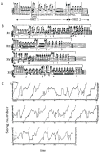Investigation of musicality in birdsong
- PMID: 24036130
- PMCID: PMC3947120
- DOI: 10.1016/j.heares.2013.08.016
Investigation of musicality in birdsong
Abstract
Songbirds spend much of their time learning, producing, and listening to complex vocal sequences we call songs. Songs are learned via cultural transmission, and singing, usually by males, has a strong impact on the behavioral state of the listeners, often promoting affiliation, pair bonding, or aggression. What is it in the acoustic structure of birdsong that makes it such a potent stimulus? We suggest that birdsong potency might be driven by principles similar to those that make music so effective in inducing emotional responses in humans: a combination of rhythms and pitches-and the transitions between acoustic states-affecting emotions through creating expectations, anticipations, tension, tension release, or surprise. Here we propose a framework for investigating how birdsong, like human music, employs the above "musical" features to affect the emotions of avian listeners. First we analyze songs of thrush nightingales (Luscinia luscinia) by examining their trajectories in terms of transitions in rhythm and pitch. These transitions show gradual escalations and graceful modifications, which are comparable to some aspects of human musicality. We then explore the feasibility of stripping such putative musical features from the songs and testing how this might affect patterns of auditory responses, focusing on fMRI data in songbirds that demonstrate the feasibility of such approaches. Finally, we explore ideas for investigating whether musical features of birdsong activate avian brains and affect avian behavior in manners comparable to music's effects on humans. In conclusion, we suggest that birdsong research would benefit from current advances in music theory by attempting to identify structures that are designed to elicit listeners' emotions and then testing for such effects experimentally. Birdsong research that takes into account the striking complexity of song structure in light of its more immediate function - to affect behavioral state in listeners - could provide a useful animal model for studying basic principles of music neuroscience in a system that is very accessible for investigation, and where developmental auditory and social experience can be tightly controlled.
Copyright © 2013 Elsevier B.V. All rights reserved.
Figures







References
-
- Abe K, Watanabe D. Songbirds possess the spontaneous ability to discriminate syntactic rules. Nature Neuroscience. 2011;14:1067–U173. - PubMed
-
- Adret P. Operant-Conditioning, Song Learning and Imprinting to Taped Song in the Zebra Finch. Animal Behaviour. 1993;46:149–159.
-
- Amrhein V, Korner P, Naguib M. Nocturnal and diurnal singing activity in the nightingale: correlations with mating status and breeding cycle. Anim Behav. 2002;64(6):939–944.
-
- Araya-Salas M. Is birdsong music? Evaluating harmonic intervals in songs of a Neotropical songbird. Animal Behaviour. 2012;84:309–313.
Publication types
MeSH terms
Grants and funding
LinkOut - more resources
Full Text Sources
Other Literature Sources
Miscellaneous

